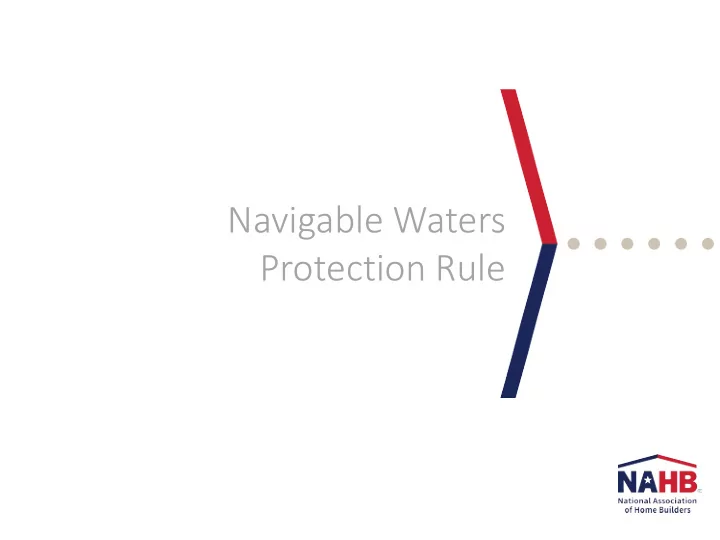

Navigable Waters Protection Rule
Summary • WOTUS Impacts Many CWA Programs • WOTUS Definition Has a Long History • Navigable Waters Protection Rule (NWPR) Provides Vast Improvements Over Prior Rules • Examples: How NWPR Treats Ditches, Wetlands, and Tributaries • Clarification is Required for Implementation • States Could Respond • Next Steps and Discussion
WOTUS Impacts Many CWA Programs • Clean Water Act (CWA) covers “navigable waters”, defined as “waters of the United States (WOTUS), including the territorial seas” • WOTUS defines the scope of federally-regulated waters and impacts • § 404 dredge and fill permits • § 402 pollutant discharge permits • § 303 Water Quality Standards and Total Maximum Daily Loads • CWA § 404 and § 402 can also initiate requirements under the Endangered Species Act and National Historic Preservation Act
Jan WOTUS Definition Has 2020 Sep A Long History 2019 Dec NWPR 2018 Feb Repeal Rule 2017 Jun Proposed Rule 2015 Dec E.O. 13778 2008 Jun 2015 Rule 2006 Jan 2008 Guidance 2001 Nov Rapanos v. U.S. (adjacent wetlands to tributary) 1986 Dec SWANNC v. Corps (isolated wetlands) 1985 1986 Rule U.S. v. Riverside Bayview (abutting wetlands)
NWPR Provides Vast Improvements Over Prior Rules Feature NWPR 2015 Rule 1986 Rule •Territorial seas & TNWs •Tributaries •Lakes and ponds, and impoundments •Adjacent wetlands •Adjacent waters •Interstate waters & wetlands •Significant nexus & similarly situated •100-yr floodplain •¼ mile of OHWM & significant nexus = jurisdictional feature = not jurisdictional feature Key:
NWPR Provides Vast Improvements over Prior Rules (cont’d) • New exemptions • Diffuse stormwater runoff • Ephemeral features • Ditches • Non-jurisdictional features • Existing exemptions • Groundwater • Stormwater control features • Prior converted cropland • Water-filled depressions
NWPR Provides Vast Improvements over Prior Rules (cont’d) • New definitions • Typical year: w/in normal range of precipitation over rolling 30-year period • Adjacent wetlands: abut, are inundated by, or are physically separated from a jurisdictional water if a surface connection remains in a typical year • Intermittent: surface water flowing continuously during certain times of the year and more than in direct response to precipitation • Upland: land area that does not satisfy all three wetland factors
The proposal is a MAJOR IMPROVEMENT over prior WOTUS definitions and will GREATLY BENEFIT builders and developers • Easier to understand ― supports observable jurisdiction • Predictable and consistent ― eliminates significant nexus test • Reduces regulated area ― ends regulation based on geographic area and narrows regulated ditches Source: Modified from U.S. EPA
Example: How NWPR Treats Jurisdictional Ditches Relocate a tributary? Constructed or excavated channel Ditch? Constructed in a Jurisdictional used to convey tributary? water? Constructed in a wetland and provide intermittent or perennial flow to a TNW?
Example: How NWPR Treats Wetlands Abut a territorial sea, TNW, tributary, or lake, pond, or impoundment (i.e., jurisdictional water)? Inundated by flooding from a jurisdictional Jurisdictional Wetland? water in a typical year? Separated from a jurisdictional water • Only by a natural feature or • Only by a physical structure and maintains a surface connection in a typical year?
Example: How NWPR Treats Tributaries Flows to a jurisdictional water through a • Channelized non- jurisdictional feature; • Subterranean river; River, stream, • Artificial feature; or or similar Perennial or • Natural feature? naturally- Tributary? intermittent Jurisdictional occurring flow? surface water channel?
Clarification Is Required for Implementation • Explain how to identify natural berms, banks, or dunes • Natural berms, banks, or dunes do not sever the jurisdiction of adjacent wetlands but NWPR does not explain how to identify them • Distinguish ephemeral from intermittent tributaries • NWPR exempts ephemeral features that form only in response to rainfall but identifying such features can be challenging (e.g., melting snow fall vs. pack) • Apply the “upland” definition • NWPR distinguishes uplands from wetlands but Regional Supplements allow the Corps to assume presence of non-observed wetland factors
States Could Respond Regulate beyond proposed NWPR & likely to continue current permitting practices May change state programs to provide some coverage of non- WOTUS features under NWPR Unlikely to increase practices due to federal regulation changes Note: Analysis based on proposed rule and applies only to dredged/fill permitting Source: Economic Analysis for the Navigable Waters Protection Rule: Definition of “Waters of the United States”. U.S. EPA
Next Steps and Discussion • Effective date is 60-days after publication on June 22, 2020 • Litigation could affect implementation • California, et al. v. Wheeler, 20-cv-3005 (N.D. Cal.) • Conservation Law Foundation, et al. v. EPA, No. 20-cv-10820 (D.Mass.) • Chesapeake Bay Foundation & ShoreRivers v. Wheeler, No. 1:20-cv-01064 (D. Md.) • SC Coastal Conservation League v. Wheeler, No. 20-cv-1687 (D. S.C.) • New Mexico Cattle Growers’ Ass’n v. EPA, 19-cv-988 (D.N.M. 2019) • EPA and USACE are developing new guidance documents and fact sheets
More Information Evan Branosky Environmental Policy Program Manager National Association of Home Builders ebranosky@nahb.org | (202) 266-8662 NAHB.org/WOTUS We Build Communities
Recommend
More recommend